Reader's Choice
Popular articles
Various hygiene products can be found on the shelves of shops and pharmacies: antiseptic, collagen, antibacterial, moisturizing, cleansing, invigorating gels, etc. Of course, each means moisturizes, softens and gives our skin elasticity. But an attractive appearance is not the most important thing for hands, it is much more important to monitor their hygiene and health. That is why people need to know which means are simply necessary for daily use, and which one serves as a good addition to other similar products.
They differ in composition, respectively, and their degree of effectiveness is completely different. As you know, the most important way to prevent many diseases is hand hygiene, therefore the WHO (World Health Organization) specially developed many recommendations for this. This document contains the final conclusions of world scientists. So, what is written there?
According to scientists, for daily protection you need to choose a gel for the hands, which is composed of isopropyl or ethyl alcohol. For antiseptics, it is important to have not only these two components, but also special additives - isopropyl myristate and tritanolamine. These substances, in turn, serve as a direct guarantee of the destruction of pathogenic microbes.
The most important thing when buying a product is to pay attention to the percentage of alcohol in its composition. Antiseptic hand gel must have at least 60, but not more than 80% of the mentioned substance. What is the importance of this requirement? If the amount of alcohol is below 60%, then the effectiveness of the product is 0. And in some cases, the tool may even become a breeding ground for bacteria. As for the 80% product, many people know that alcohol is most effective in a humid environment, and if its amount exceeds this mark, the product will dry out the skin. Thus, antiseptic hand gel will not bring any effect. That is why before buying it is important to pay attention to the level of isopropanol concentration in the selected product.
The most vulnerable and vulnerable place of our body is hands. They are most often exposed to the negative effects of the surrounding world. Therefore, we should make it a rule to apply an antiseptic hand gel to the skin daily. And if you do not pay them proper attention, they will not just lose their attractiveness, and over time they will not be able to resist many environmental aggressors.

It is a mistake to believe that well-groomed hands and a neat manicure are for lazy people. As one famous person said: "The hand is the human brain that has come to the surface." And even if they present the right outfit, competent speech, perfect makeup, hair - the type of unkempt hands can tell a lot more about you. They are able to give all your diseases. Agree, pale, dry, cracked and irritated skin is an unpleasant sight. And if you add to this image the absence of a manicure, then even the strongest male nerves can not stand such a picture.
Many of us do not notice how many daily activities we perform. For example, we pay for travel in transport or in a store, shake hands with each other, touch door handles, contact with domestic (and not only) animals. Perhaps, visually, our hands seem to be clean, but, you can be sure, there are already thousands of different bacteria there.

To destroy them, you need to wash your hands with soap and warm water. This is a truism. But! So it was about ten years ago. And what do we have today, when the eyes of a variety of similar products scatter? What is better to buy - soap or hand gel (antiseptic)? Feel free to choose the last option! Soap is stored in a soap dish, and it becomes an excellent home for bacteria, but with an antiseptic gel, packaged in bottles that have a dispenser, this danger does not threaten you.
Any of us was in a situation where it was necessary, but it was not possible to wash our hands. And if for men it is a problem, then in the women's purse, of course, there is a tool that can help out of this unforeseen situation. The main thing is that it is effective.
Manufacturers of wet wipes make the same mistake: they say that their products do not contain alcohol and spares the skin. As you know, a humid environment is a heavenly place for the reproduction of bacteria, viruses and pathogens, and it is napkins that create this environment. In addition, there are at least two more problems. Where to throw the used napkin, if there is no urn nearby, and how to get rid of the stickiness that causes discomfort?

In such cases, the gel will be a reliable helper in this situation. To clean your hands, quickly rub to a full absorption just one drop of the product. It is not necessary to wash it off: the alcohol in its composition will evaporate in a few seconds, and the handles will not only be clean, protected, but also dry.
At first glance it seems that there is not much difference between these means, but it is not. able to fight only against bacteria, but antiseptic, in addition, destroy viruses, which become the main causative agents of various diseases - herpes, tuberculosis, intestinal infections, influenza and Botkin's disease. Below we consider the most popular and effective products.
Hand gel (antiseptic) of this brand has long established itself as a budget and effective tool. Based on the feedback from people, you can give him the following description:
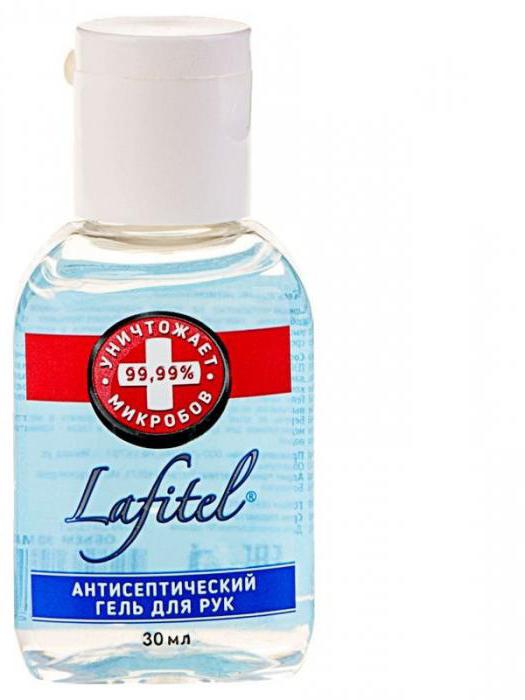
You can buy goods at any pharmacy. The average cost of one bottle - 50 rubles
"Sanitel" - hand gel (antiseptic) of domestic production, contains 62% alcohol and glycerin. This means that it not only fights bacteria, but also moisturizes the skin. The tool is very economical. According to customers, Sanitelle antiseptic hand gel at the beginning of use has a strong odor of alcohol, but after a few minutes there is a pleasant aroma of aloe vera on the hands.
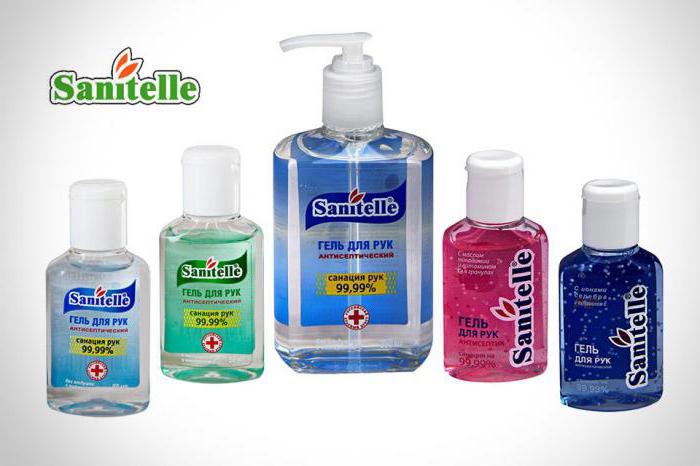
There is also a children's antiseptic gel "Sanitel Kids". According to the manufacturer, the tool can kill up to 99% of pathogens in seconds, which is very important for protecting the child’s body. The gel does not dry the delicate skin of the baby’s hands, as it contains vitamin E and aloe vera extract. According to consumers, the tool does not cause allergic reactions and has a sweet gum flavor.
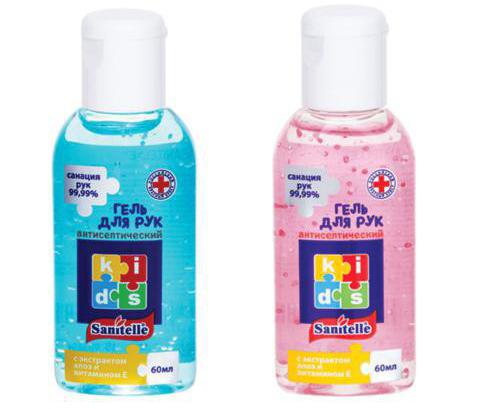
Effective antiseptic gel based on alcohol. When applied to the skin does not cause feelings of tightness, stickiness or drying. As for smell, during use it has a sharp alcoholic aroma, which disappears in a few seconds. The feeling of clean hands is present for several hours, and it is very comfortable in the living conditions. According to satisfied consumers, the Clean Hands antiseptic gel is a very economical and budgetary product.

Alcohol based antiseptic gel. On sale goes packaged in bottles with dispenser. Conveniently, the tool can be purchased both in small containers and in a half liter. The gel is used not only for personal hygiene, but also for disinfecting hands before surgery. The method of application is simple: apply the gel on the palm and carefully grind. Active protection will begin in 30 seconds.
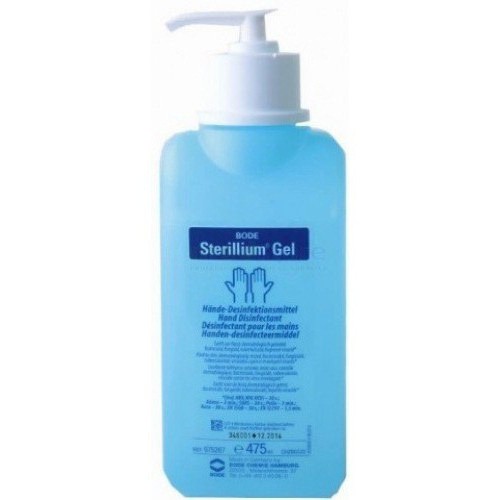
Of course, soap is a very good helper in cleansing, but antiseptic hand gel is considered the best disinfecting agent. Reviews of this product indicate that today it is the most reliable protection of the skin against viral diseases and pathogenic microorganisms.
There are a number of activities for the representatives of which cleanliness of hands is no less important than professionalism. These are doctors, cooks, cosmetologists and, of course, manicurists. And if the tools intended for processing the skin and the nail plate are cleaned in a special way under the action of very high temperatures in heat-resistant cabinets (sterilizers), then special tools will help to keep your hands clean. Similar compounds are also used for medical purposes, acting as an alternative or addition to the usual hand washing with soap and water.
The composition of antiseptics, as a rule, includes one of the active components, destroying pathogens. This may be ethanol, isopropanol, triclosan compounds or Providone-iodine. To mitigate the effect of such a substance on the skin, glycerin, herbal extracts that also have an antimicrobial effect (chamomile), thickeners, and fragrances can also be added to the gel antiseptic. Alcohol-free formulations are usually recommended for those whose skin on their hands is sensitive.
In our catalog you will find funds from such well-known brands like Severin, Sanitel, IBD, Almadez, Gi-Gi and other brands that produce quality products. All products are of original origin, which is confirmed by quality certificates.
In everyday life, there are often situations when you need to wash your hands, and there are no opportunities for this, for example, on the road, on vacation or on a walk. In addition, a long stay in public transport and contact with handrails, seats carries the risk of contact with germs on the skin. That is why hygienic antiseptic of hands is so important, which not only returns the feeling of purity, but also protects against certain diseases.
Such tools, for the most part, are used in medical institutions to prevent the spread of pathogenic microorganisms and hygiene. But this antiseptic for hands gradually entered into everyday life and ordinary people, being a convenient means of disinfecting the skin in household use.
Most of the remedies in question contain at least 60% alcohol, so they eliminate various types of bacteria and fungi, such as tubercle bacilli, staphylococci, and streptococci. In addition, skin antiseptics for hands is effective against viruses (ARVI, flu).
Naturally, destroying pathogenic bacteria, these drugs do not leave the skin and the normal microflora of the body, and also eliminate the surface protective fat layer. But this negative aspect is manifested to a much lesser extent than with the usual washing of hands with soap.
The composition of the considered tools include the following active ingredients:
As auxiliary components, various thickeners, aromatic constituents, (to retain moisture in the skin cells), vitamin and plant extracts, propylene glycol, polyacrylic acid are used.
For sensitive skin antiseptics are provided that do not contain alcohol. In this case, the active substance is benzalkonium chloride or triclosan.
Frequent trips in public transport, daily movements around the city and an abundance of contacts - infections lurk everywhere. Careful hygiene is practically the only remedy that will help protect your health. For such cases, a special substance was created - an antiseptic for hands, which became an essential attribute of women's cosmetics, such as powder or lip balm. This disinfectant is mobile - comes in the form of gels, napkins and sprays that fit even in a small handbag.
This is a special disinfectant fluid, the purpose of which is to prevent the growth of bacteria and other microorganisms. Antiseptics are widely used in the medical field. Here are the most famous of them: iodine, brilliant green, hydrogen peroxide. Before the advent of these disinfectants, doctors rarely took the risk of performing operations involving the dissection of the body, since the procedure was often fatal due to rapidly developing infections.
In the modern world, special antiseptics are widely used not only in the medical field, but also in the food industry, they are found in detergent compositions, paints and varnishes, in nail salons and beauty studios. There is no need to use these products in everyday life - for everyday use there are convenient and effective antibacterial liquids. They are called modern word - sanitizer. Recently, they have entered the list of necessary personal hygiene products.
The main element of the antiseptic composition for hands is alcohol, the concentration of which should be at least 60%. Other chemicals in the sanitizer composition may vary by manufacturer, but some components are the same. In addition to the alcohol base, glycerin and propylene glycol, which are also used in the medical and food fields, are essential elements of the composition of the antibacterial agent. Glycerin is used as a thickener, and propylene glycol disinfects the air.

Manufacturers add to antiseptic for hands:
On sale there are hygienic antiseptics without alcohol base for those who have sensitive skin. They are often used in childcare facilities (kindergartens, schools), in cafes and restaurants. The composition of such disinfectants contains the smallest amount of ethyl alcohol, and the main component is a salt solution with the addition of other anti-allergenic chemicals.
In order for all harmful bacteria to die, and for the hands to be maximally protected from the attack of microorganisms, it is necessary to follow some classical methods of processing hands with a disinfecting agent:
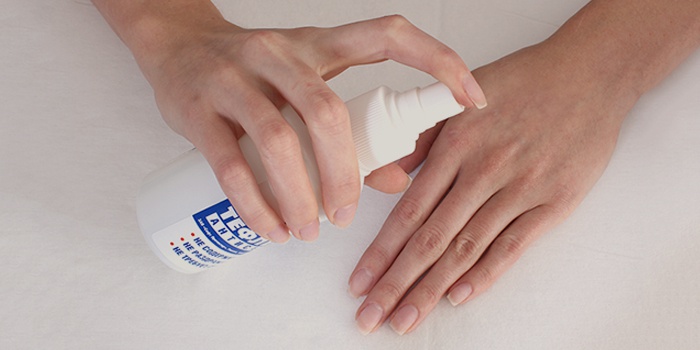
We should not forget that the frequent use of antiseptics can adversely affect human health - the liquid will kill not only harmful organisms, but also beneficial bacteria that protect the skin from infections. When it comes to the use of sanitizers, it is important not to overdo it when it comes to children - young parents seek to sanitize not only all the objects surrounding the child, but also the baby’s skin, destroying the natural barriers. A sterile environment will not benefit the child.
Antibacterial agents for hands are represented on the market by a wide range of manufacturers. Due to their growing popularity, every day the product is more and more common on the shelves of supermarkets and pharmacies. For convenience, manufacturers of antiseptics present their products in various forms:
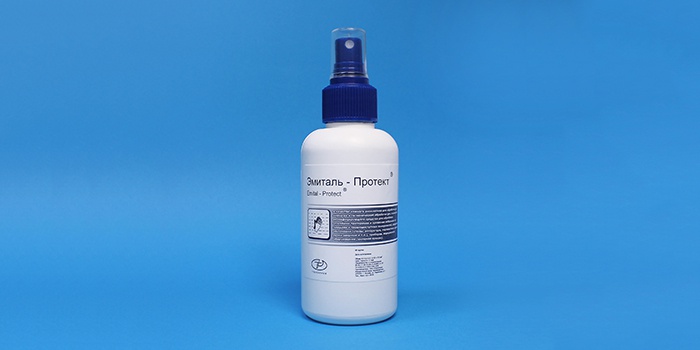
One of the latest antiseptic products is a hand sanitizer spray. The bottle with the batcher is suitable for use on the street, in cafe, medical institutions and other places of a big congestion of people. Spray disinfectant covers a large area without forming a film, but due to the high alcohol content, it sometimes dries the skin. One of the most popular sanitizers is Protect Hand Spray, with an approximate retail price of 75 to 100 p. The company "Emital" produces similar products at a price of 270 - 300 p.
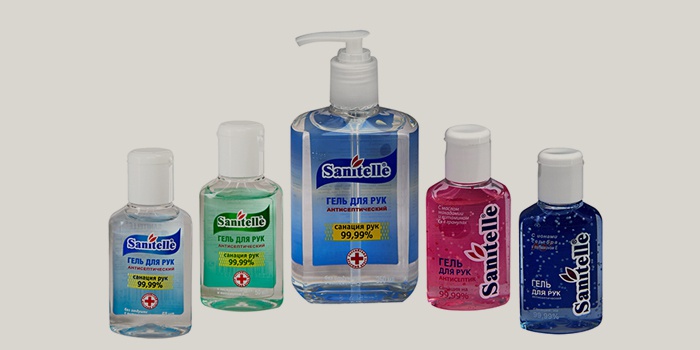
Antiseptic and disinfectants in the form of a gel - the most popular type of sanitizer. This tool is convenient to store in the drawer of the office desk. In the "field" conditions, in a hurry, then pouring more or less liquid than necessary. A loosely closed bottle cap is carelessly likely to damage the bag or things. Sanitelle antiseptic gel for hands is found on the shelves of pharmacies and supermarkets, which costs about 70–80 p. for 50 ml jar. Means of the same volume of the company “Velvet handles” are sold at a price of 80–90 p.
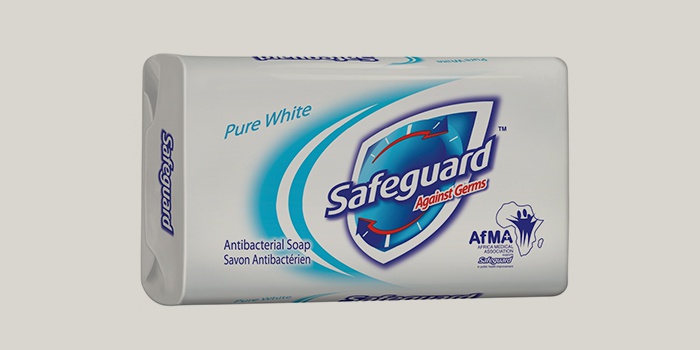
This type of antibacterial agents is the best antiseptic. It is designed for use at home. Safeguard and Dettol antiseptics are popular among manufacturers. The approximate cost of soap briquettes from both companies is about 50 rubles. An obvious advantage of this tool is that every child who does not understand how to use gel or spray can learn how to use it at home. Liquid antiseptic soap with an automatic dispenser is a popular attribute of restrooms of medical institutions, cafes and restaurants.

This category of antibacterial agents is suitable for people leading an active lifestyle. Napkins soaked in an antiseptic composition, are used not only for wiping hands, but also objects, for example, for simulators in the gym or car steering wheel. Such sanitizers do not take up much space - they are convenient to use when traveling. The company Kleenex offers to purchase antibacterial wipes at a cost of 30 rubles. 15 pieces, and the company Salfeti - from 30 to 40 p. for the same number of products.
If desired, you can create your own antiseptic for hands on a natural basis. The recipe includes the following ingredients:
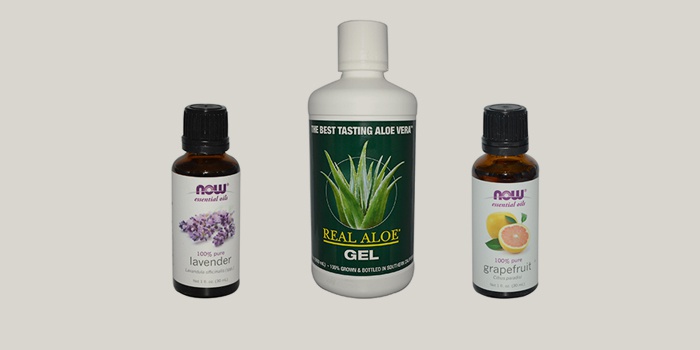
Detailed instructions for creating a liquid antiseptic for the skin:
An interesting video below will show the benefits of using antibacterial agents for the hands. Which antiseptic is better to choose? What is more convenient to use in everyday life - spray, napkins, soap or disinfecting hand gel? Are sanitizers harmful? Where is it possible to take comfortable and mobile antiseptics for hands? If you want to know the answers to all these questions and take care of your own health, then this video is for you.
Each of us throughout the day is in contact with various items that are potential carriers of bacteria and infections. Pathogens can be transmitted through handshakes, money, objects in crowded places, etc. Soap is a good and proven tool for cleansing hands and disinfecting them, but it only allows temporary removal of bacteria from the skin. For this reason, hand antiseptics have appeared on the market of household hygiene products.
Hand antiseptic is a special agent with antimicrobial and antiviral effects, through which you can cleanse the skin at any time, thereby preventing infection with various diseases. As a rule, high-quality household antiseptic can protect a person from pathogenic microorganisms for 5-6 hours after hand treatment.

Modern manufacturers of personal care products have developed a wide range of products that have their own characteristics and specificity of use. For example, for individuals who are constantly confronted with a money bill, there are special antiseptic drugs that are aimed at killing bacteria most often present on bills.
Antiseptics have long been used in medicine, but for household use products began to be produced quite recently. According to the Ministry of Health, since the mass distribution of antiseptics among the population, cases of acute infectious diseases have significantly decreased. This confirms the high relevance of drugs in this group and the need to use them for domestic purposes.
The composition of antiseptics for hands is determined by their type. At the same time, products of the same type may include several active ingredients that increase the effectiveness of the drug for everyday use among the population. It is necessary to highlight a number of components that determine the type and purpose of an antiseptic preparation:
A feature of household antiseptics in contrast to the means of general use is the absence of chlorine as a component. At the same time, antiseptic hand instruments may have the following appearance:
It is important to remember that any types of products can be applied to the treatment of hands, but if there are injuries on the skin, alcohol-containing liquids should be discarded.
Modern antiseptic preparations - this is no longer a wonder, but a means of personal hygiene, without which it is hard to imagine life in a big city. To facilitate consumer choice and increase the degree of efficiency of hygienic products, pharmacological and cosmetic companies are developing highly specialized lines of products for personal use. Below is a detailed list of household antiseptics with different purpose, shape and composition. After reviewing the most popular products, you can make a choice in favor of one or another tool that would be most appropriate in a particular situation.
Antiseptic preparation from Sterillium is an alcohol-based product, presented in the form of a gel with a dispenser. For sale composition in a convenient container with a volume of almost half a liter and in small bottles for carrying with them. The tool is used to clean hands as part of personal hygiene, before surgery, injections and even to treat minor skin lesions to prevent infection. The product is effective in combating herpes simplex viruses of group A, influenza, hepatitis, staphylococcus, Escherichia coli, etc. To use, apply the gel on the palms of your hands and rub them well. The process of active protection starts 30 seconds after applying the composition to the skin of the hands.
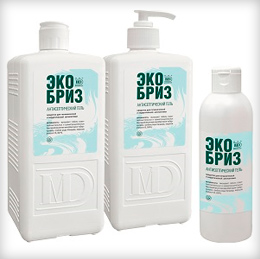 "Eco-breeze" is an alcohol spray, which is sold in bottles with a spray in the amount of 1000 milliliters. Apply means for disinfecting hands in medical institutions for the purposes of therapeutic and preventive activities, in laboratory studies and other areas of service. The tool is also important for domestic use. It has bactericidal and antimicrobial properties, which makes it possible to use the component in order to prevent various infectious diseases transmitted through direct contact with the object. It is possible to use the product both for processing the surface of hands, and for disinfecting objects that are resistant to the effects of alcohol.
"Eco-breeze" is an alcohol spray, which is sold in bottles with a spray in the amount of 1000 milliliters. Apply means for disinfecting hands in medical institutions for the purposes of therapeutic and preventive activities, in laboratory studies and other areas of service. The tool is also important for domestic use. It has bactericidal and antimicrobial properties, which makes it possible to use the component in order to prevent various infectious diseases transmitted through direct contact with the object. It is possible to use the product both for processing the surface of hands, and for disinfecting objects that are resistant to the effects of alcohol.
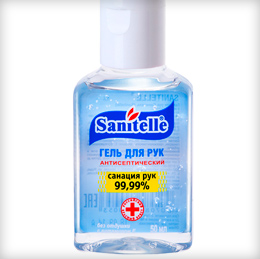 This is a quality product that is an effective antiseptic for the treatment of hands and objects. The composition destroys in a few seconds 99 percent of all known infections and bacteria, which makes it indispensable for child care. The disinfecting component does not dry the pens to the baby, because it contains aloe extract and vitamins of group E. It has a pleasant smell of chewing gum, which is especially popular with children. The tool does not cause allergic reactions and can be applied to all skin types.
This is a quality product that is an effective antiseptic for the treatment of hands and objects. The composition destroys in a few seconds 99 percent of all known infections and bacteria, which makes it indispensable for child care. The disinfecting component does not dry the pens to the baby, because it contains aloe extract and vitamins of group E. It has a pleasant smell of chewing gum, which is especially popular with children. The tool does not cause allergic reactions and can be applied to all skin types.
 Dettol gel is an effective alcohol-based antiseptic. It has a specific alcohol odor, which quickly disappears. When applied to the hands does not cause discomfort in the form of stickiness, tightness and drying. In a matter of seconds, it kills bacteria and microorganisms on the skin of the hands. After use, the effect of washed hands persists for several hours, which is quite convenient for domestic use of the drug. It should also be noted that the tool is quite economical and has a low cost.
Dettol gel is an effective alcohol-based antiseptic. It has a specific alcohol odor, which quickly disappears. When applied to the hands does not cause discomfort in the form of stickiness, tightness and drying. In a matter of seconds, it kills bacteria and microorganisms on the skin of the hands. After use, the effect of washed hands persists for several hours, which is quite convenient for domestic use of the drug. It should also be noted that the tool is quite economical and has a low cost.
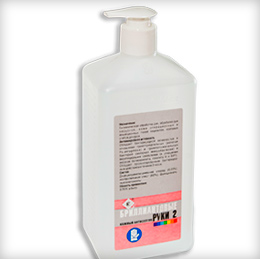 The means "Diamond hands", intended for health professionals is an antiseptic preparation, which includes isopropyl alcohol, didecyldimethylammonium chloride and additional components. The product is intended for hand disinfection during surgical procedures and therapeutic and preventive activities. The composition allows you to destroy most of the known viruses and bacteria. The duration of the antiseptic product is longer than three hours after hand treatment.
The means "Diamond hands", intended for health professionals is an antiseptic preparation, which includes isopropyl alcohol, didecyldimethylammonium chloride and additional components. The product is intended for hand disinfection during surgical procedures and therapeutic and preventive activities. The composition allows you to destroy most of the known viruses and bacteria. The duration of the antiseptic product is longer than three hours after hand treatment.
Video: how to make an antiseptic at home
| Related articles: | |
|
Decoding of markings and informational signs
Federal Customs Service State Educational ... Tea with milk: more good or all the same harm?
What is the use of this "cocktail", and also about whether it can harm, ... Skin antiseptic for hands
On the shelves of shops and pharmacies you can find various means for hygiene: ... | |